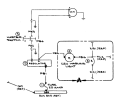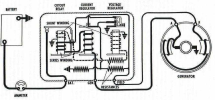This is how Cessna typically did it:
View attachment 120627
Note that the master switch has two sets of contacts, and one of them connects the generator field to the regulator's field terminal. Now, if that switch was bad, the generator could not get up enough output to extinguish the warning light at 1200 RPM. Another possibility is a ridiculously easy one: a burned-out Gen fuse.
This is the basic idea:
View attachment 120628
If the regulator's cutout winding wasn't working, or the contacts shot, the light would go out but nothing would reach the bus (battery).
If the current regulator's contacts were burned out, the field wouldn't get anything and the light wouldn't go out.
If the voltage regulator's contacts were shot, again, the light wouldn't go out, since the field would be getting nothing.
So it's probably a maladjusted regulator, or a bad set of cutout contacts. Or that burned-out fuse. And don't just look at the fuse; they have a bad habit of corroding between the fuse strip and the end caps. Use an ohmmeter. And the contacts in the fuseholder also corrode.
No such thing as a cheap old airplane.




